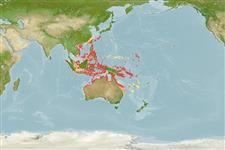Environment: milieu / climate zone / depth range / distribution range
Ekologi
laut berasosiasi dengan karang; kisaran kedalaman 1 - 20 m (Ref. 90102). Tropical; 30°N - 24°S
Western Pacific: Indochina to Papua New Guinea, north to Ryukyu Islands, south to northwestern Australia and the Great Barrier Reef. Replaced by Meiacanthus kamoharai in southern Japan.
Size / Weight / umur
Maturity: Lm ? range ? - ? cm
Max length : 11.0 cm TL jantan/; (Ref. 9710)
deskripsi pendek
Kunci identifiaksi (pengenalan) | Morfologi | Morfometrik
Duri punggung (Keseluruhan (total)) : 4; duri punggung lunak (Keseluruhan (total)) : 25 - 28; Duri dubur: 2; Sirip dubur lunak: 14 - 16. Identified by the lined pattern on the body that ends in spots on the tail-fin base (Ref. 48636).
A solitary species found in sheltered lagoon and seaward reefs (Ref. 9710, 48636). Several adults together occasionally in close vicinity to each other (Ref. 48636). Oviparous. Eggs are demersal and adhesive (Ref. 205), and are attached to the substrate via a filamentous, adhesive pad or pedestal (Ref. 94114). Larvae are planktonic, often found in shallow, coastal waters (Ref. 94114). Several geographical variations and is mimicked by another blenny Petroscirtes breviceps (Ref. 48636). Both fang and venom gland are present (Ref. 57406).
Oviparous, distinct pairing (Ref. 205).
Myers, R.F., 1991. Micronesian reef fishes. Second Ed. Coral Graphics, Barrigada, Guam. 298 p. (Ref. 1602)
Status IUCN Red List (Ref. 130435: Version 2024-2)
penggunaan manusia
Perikanan: komersial; Akuarium: Komersial
Alat, peralatan
laporan khas
muat turun XML
Sumber internet
Estimates based on models
Preferred temperature (Ref.
123201): 26.4 - 29.3, mean 28.7 °C (based on 1647 cells).
Phylogenetic diversity index (Ref.
82804): PD
50 = 0.5000 [Uniqueness, from 0.5 = low to 2.0 = high].
Bayesian length-weight: a=0.00575 (0.00253 - 0.01308), b=3.06 (2.86 - 3.26), in cm total length, based on LWR estimates for this (Sub)family-body shape (Ref.
93245).
Trophic level (Ref.
69278): 3.4 ±0.5 se; based on size and trophs of closest relatives
Daya lenting (Ref.
120179): Tinggi, Waktu penggandaan populasi minimum kurang dari 15 bulan (Preliminary K or Fecundity.).
Fishing Vulnerability (Ref.
59153): Low vulnerability (10 of 100).
Nutrients (Ref.
124155): Calcium = 136 [70, 243] mg/100g; Iron = 0.887 [0.517, 1.547] mg/100g; Protein = 18 [17, 19] %; Omega3 = 0.0885 [, ] g/100g; Selenium = 23.6 [11.2, 54.0] μg/100g; VitaminA = 188 [54, 677] μg/100g; Zinc = 2.04 [1.35, 2.94] mg/100g (wet weight);
